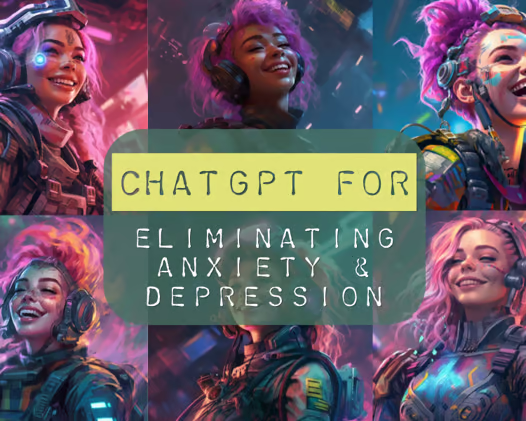Dear Cyborgs,
Picture this: You’re in the throes of a depressive episode, your ADHD or anxiety making it impossible to pin down your racing thoughts.
You desperately need a means to vent, to process, to heal.
Enter ChatGPT as your unlikely ally in this struggle.
As Memorial Day passes, we honor those who served, and we stand with those battling mental health issues, especially the veterans navigating an insufficient VA support system.

The unsettling statistic of 22 veterans succumbing to their mental health struggles daily underscores the urgency of change.
We firmly believe that the potential of ChatGPT, our tech ally in emotional exploration and expression, can significantly impact this troubling trend.
While many people primarily utilize ChatGPT for technical pursuits, it’s critical to understand the profound potential this tool has in helping us gracefully navigate personal challenges.
It is by no means a resource exclusively for tech enthusiasts; it can significantly enhance our health, relationships, and overall well-being, helping us become more composed and content individuals.
ChatGPT can seamlessly take our most disorganized thoughts and structure them into lucid and eloquent prose.
It provides a form of assistance akin to having a personal AI confidante – a non-judgmental space where you can freely express your raw and unfiltered emotions, and have them transformed into something poignant and meaningful.

I find a profound solace in transmuting my thoughts into free verse poetry or melodic songs with the aid of ChatGPT, an experience that elevates the process to an art form.
Often, during moments of melancholy, we seek refuge in music that gives voice to our unuttered feelings.
Engaging in this act of creation provides a therapeutic channel for our emotions, a conduit through which we can navigate our experiences.
A Step-by-Step Guide to Processing Your Emotions as Art with ChatGPT

Step 1: Acknowledge and Embrace Your Emotions
Before you can transform your emotions into poetry, you need to first truly feel them.
Instead of trying to analyze or suppress your emotions, take a moment to tune into your body and observe the sensations that arise with each emotion.
It could be a tightening in your chest, a flutter in your stomach, or a warmth spreading through you.
Regardless of how these emotions manifest, they are valid parts of your experience.
During this stage, try to adopt a curious attitude towards your emotions.
Embrace them, sit with them, even if they might be uncomfortable or intense, and remember they each have a purpose.
Step 2: Free-Write Your Emotion
Once you’ve acknowledged and fully felt your emotion, try free-writing about it.
Just let your thoughts flow onto the page without self-editing.
It may not sound eloquent or coherent at first, and that’s perfectly okay.
The important thing is that you’re giving your feelings a voice.
Step 3: Engage with ChatGPT
After you’ve poured your feelings onto the page, share your free-written thoughts with ChatGPT.
Begin with a simple statement like, “I’m feeling emotion, can you help turn these thoughts into a free verse poem?”
Step 4: Collaborate and Shape Your Poem
ChatGPT will then provide a draft of a poem based on your input.
If it’s not exactly what you’re looking for, remember that you can always tweak the prompts, edit the input, or even ask for a new version.
You’re in control, and ChatGPT is here to assist.
Step 5: Refine and Personalize

When you’re happy with the basic structure and theme of your poem, start refining it.
You could rephrase a line to improve the rhythm, change words to better capture your emotion, or adjust the style to make it more authentically you.
During this stage, don’t hesitate to ask ChatGPT for suggestions on individual lines or phrases.
You can also ask it to “make it sound more passionate” if it fails to convey your thoughts appropriately.
Step 6: Celebrate Your Creation
Once you’ve refined your poem, take a moment to appreciate what you’ve created.
You’ve taken raw emotions and transformed them into something beautiful.
Allow yourself to revel in this accomplishment.
Step 7: Reflect
Finally, reflect on the process and your poem.
Did writing it change your understanding of your feelings?
Did it give you a new perspective or a sense of release?
This reflection adds another layer to your journey of emotional exploration.
Remember, the goal isn’t to create a perfect poem, but to authentically express your emotions.
If it doesn’t come naturally at first, don’t worry.
With time and practice, you’ll find this to be an enriching and therapeutic way to navigate your emotional landscape.
Now, use this process for each of the tips below.
Here’s a list of creative ways you can utilize ChatGPT to navigate various emotional and practical challenges:

1. Depression and ADHD Management: ChatGPT can help you manage symptoms of depression and ADHD by allowing you to articulate your thoughts and feelings without judgment, turning mental clutter into meaningful insights.
How-To: Begin by expressing your feelings to ChatGPT. Write about how you’re feeling or what’s going through your mind in as much detail as you can. It’s okay if your thoughts are scattered or seem incoherent – just get them out. Then, ask ChatGPT to help organize these thoughts into coherent text, or to turn them into a poem, story, or song.
2. Therapeutic Substitute: With access to therapy being challenging, ChatGPT can act as an interim counselor, helping you vent your thoughts without the stress of re-traumatizing yourself by repeating your experiences to different therapists you do not yet trust.
How-To: Start a conversation with ChatGPT as if you’re speaking to a therapist. Share your emotional struggles, your experiences, your fears and hopes. Ask it for its perspective, or to provide soothing words of comfort. While ChatGPT isn’t a licensed therapist, it can offer a non-judgmental space for you to vent and process your emotions when professional help isn’t immediately available.
3. Avoiding Reactive Arguments: When upset, instead of reacting impulsively, try to translate your response into a poem or song with ChatGPT’s help. This method aids in emotional processing and leads to more mindful communication.

How-To: If someone has upset you, and your immediate reaction is to lash out, pause. Write down what you want to say to them in the ChatGPT window, as raw and as angry as it might be. Then, ask the AI to transform your words into a poem or song. This can provide a creative and cathartic outlet for your feelings, enabling you to express them without causing unnecessary conflict.
4. Managing Anxiety: Use ChatGPT as a spiritual coach. Input your anxiety-inducing situation and ask it to generate positive affirmations, providing comfort before stressful encounters.
How-To: Type out the situation that’s causing you stress or anxiety in as much detail as you can. Then, ask ChatGPT to act as a spiritual coach, and to generate positive affirmations for you. Ask it to remind you of your strengths, your past victories, and the good things you have in your life. Read these affirmations aloud before you face the anxiety-inducing situation.
5. Enhancing Communication: Whether crafting text messages, meaningful apologies, love letters, or snappy comebacks, ChatGPT can help refine your words, ensuring they sound better and express exactly what you intend.
How-To: If you’re struggling to craft a message to someone – whether it’s an important email, a sensitive text message, or a social media post – write down what you want to say in the ChatGPT window first. Then, ask the AI to “make this sound better.”
6. Creativity Boost: Find inspiration everywhere, even in a TikTok video. Jot down your thoughts, however chaotic, and use ChatGPT to transform them into free verse poems, songs, or other forms of art.

How-To: Whenever something inspires you, jot down a sentence or two about it in the ChatGPT window. It could be something you saw on TV, something someone said, or a random thought that popped into your head. Then, ask ChatGPT to turn these thoughts into a free verse poem, a song, or a short story.
7. Advice and Guidance: Need solid advice without judgment? ChatGPT can offer insightful suggestions based on the details you share, without any human bias.
How-To: If you’re facing a difficult situation or decision, write it out in as much detail as you can in the ChatGPT window. Include your thoughts, feelings, and the possible options you’re considering. Then, ask ChatGPT for its perspective or for advice.
8. Emotional Processing: The practice of articulating feelings and situations to ChatGPT can enhance your emotional awareness and allow for a healthier processing of your experiences.

How-To: Share your feelings with ChatGPT, whether they’re good, bad, or something in between. This might mean venting your frustrations, expressing your joy, or pondering your confusion. Ask ChatGPT to help you explore these feelings further, or to turn them into a poem, story, or song.
9. Privacy: Store your interactions with ChatGPT in a secure Apple Notes folder. This personal repository can serve as a safe space for reflection and understanding your emotional journey over time.
How-To: Keep a record of your interactions with ChatGPT in a password-protected Apple Notes folder. This can serve as a private journal of your thoughts, feelings, and emotional growth. It’s a safe space for you to reflect on your experiences, and it’s a record of your emotional journey without worrying about prying eyes.
10. Overcoming Insecurities: Share your insecurities and fears with ChatGPT, allowing it to help you navigate and process these emotions, fostering self-acceptance and growth.
How-To: Write down your insecurities, fears, or doubts in the ChatGPT window. Then, ask it to help you process these feelings or to generate words of comfort or encouragement. This process can provide a gentle way to confront your insecurities and to start working towards overcoming them.
11. Expressing Unspoken Feelings: It’s common to harbor feelings that we find hard to articulate. These could be feelings of love, gratitude, hurt, or even disappointment towards someone in our lives. Many times, these emotions remain unspoken, leading to regrets. ChatGPT can assist in organizing your thoughts and expressing them precisely as you intend, reducing the risk of misunderstandings and unsaid feelings.

How-To: Begin by pouring out your thoughts and feelings about the person into the ChatGPT window. Write about what you appreciate about them, your shared experiences, your concerns, and what you hope for the future. Once you’ve done this, ask ChatGPT to help you articulate these feelings into a coherent, heartfelt message.
Remember, it’s not just about making it sound nice – it’s about ensuring the message conveys your true feelings and intentions. The final product can then be used as a guide for a conversation, or even sent as a letter or message.
For those grappling with mental health issues, we hope you consider exploring the potential of ChatGPT.
While it’s no substitute for professional care, it could be a supportive companion in your journey towards healing and wellness.
We encourage you to share this message with someone struggling with their mental health.
This isn’t just a newsletter, but potentially a lifeline.
This Memorial Day, let’s extend our remembrance to ignite hope, opening conversations around mental health, aiming for a future where no one is left behind.
Together, we can rewrite the narrative.

If you or anyone you know is struggling with feelings of despair or thoughts of suicide, please remember that help is available. Contact the National Suicide Prevention Lifeline at 1-800-273-TALK (1-800-273-8255). You are not alone, and there are people ready and willing to help.
Here’s to harnessing the healing power of AI in our personal journeys,
Addie LaMarr



